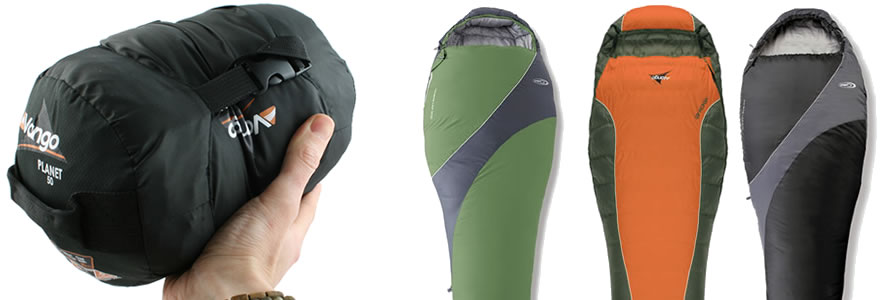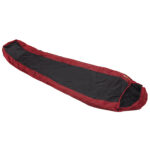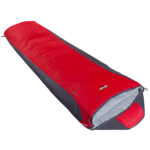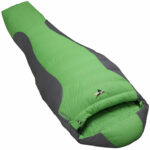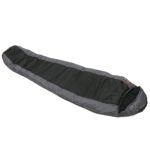It’s well known that travellers need to keep the size and weight of their gear to a minimum, so compact and lightweight gear is the key to ensuring you can fit everything inside your rucksack or backpack!
If you’re taking a sleeping bag with you, don’t fall into the trap of taking a standard sleeping bag from home, these are often cumbersome and aren’t designed with the same great features and performance you’d expect from a travel sleeping bag. Travel sleeping bags are designed to be lightweight and compact and many come with useful features tailored specifically to a backpacker’s needs.
Sleeping Bag Performance & Season Ratings
All sleeping bags come with a season rating, this indicates the conditions in which the sleeping bag will provide the best possible performance – there are currently 4 different season ratings available. You’ll also find that sleeping bags come with comfort, upper/lower limit and extreme temperatures, these are explained below.
Comfort: This is the temperature at which a woman would have a comfortable night’s sleep without being too hot or too cold.
Upper Limit: The temperature a man can sleep at without excessive perspiration.
Lower Limit: This is the temperature at which a man could sleep for 8 hours without waking up, without being too cold.
Extreme: Extreme temperatures are to be used in emergencies only and these state the temperature at which a woman could survive for 6 hours without death – frost bite would still be possible, though!
Most sleeping bags are tested to comply with the EN13537 standard.
The above information helps determine a sleeping bags season rating, so you can easily work out which travel sleeping bag would be best suited to your destination.
| Season Rating | Comfort Rating Range | Example |
|
1 |
12 to 16°C |
|
|
2 |
5 to 12°C |
|
|
3 |
-5 to 5°C |
|
|
4 |
-15 to 4°C |
|
Travel Sleeping Bag Styles
Sleeping Bag Shapes
Most travel sleeping bags come in a tapered mummy shape, this helps to keep it’s pack size as compact as possible as the sleeping bag won’t have as much material to compress as a square shaped bag. You’ll also find that the higher the sleeping bag’s season rating, the less likely you are to find it in a square shape – again this is because of pack size, as well as the fact that mummy shaped sleeping bags are better at retaining heat to keep you warm.
However, square shaped travel sleeping bags are available and are often found in 1 and 2 season options. You may find that square shaped sleeping bags are more comfortable than mummy shapes if you like to move around a lot in your sleep, mummy shaped bags tend to restrict movement of the legs, which some travellers find a little uncomfortable.
Fillings – Synthetic & Down
The most common type of sleeping bag filling for travel sleeping bags is synthetic, these are filled with synthetic fibres and have a less hefty price tag compared to down filled options on the market.
If you’re taking part in treks and other outdoor activities where you have to carry gear, down filled sleeping bags are a good option. These are filled with goose down that is super lightweight and has excellent insulating properties, which is why you tend to find more down sleeping bags in higher season ratings. However, down doesn’t perform well when wet or in damp conditions, so you would need to consider the conditions in which you plan to use it before making the investment!
Special Travel Related Features
Travel sleeping bags are designed to be as compact and lightweight as possible, but this isn’t the only travel related feature you should look out for! Some sleeping bags feature mosquito nets in the hood, anti-bacterial protection and hidden security pockets for valuables.
Here are some useful features that can be found on travel sleeping bags:
Anti-bacterial protection – These sleeping bags are treated with a special anti-bacterial treatment, helping to prevent mould and unpleasant odours after long periods of usage and in hot climates.
Anti-mosquito protection – This treatment helps to repel mosquitoes and other biting insects
Mosquito nets – Located in the sleeping bags hood, these help to protect you from bites while you sleep. You can also zip it up to stop insects climbing inside your sleeping bag during the day.
Internal stash pocket – A small pocket located inside the sleeping bag, usually with a Velcro style fastening, great for storing cash and small valuables when you’re sleeping.
Many travel sleeping bags can also be opened out and used as a blanket when you get too hot.
Sleeping Bag Liners
Sleeping bag liners help to prolong the life of you sleeping bag, acting as a washable liner that you can remove and clean when it gets dirty. Sleeping bag liners also help add warmth to your sleeping bag, particularly fleece, silk and thermolite options.
You can buy sleeping bag liners in a square or mummy shape to suit the style of your sleeping bag and they can also be used on their own in particularly hot climates.
Choosing the right sleeping bag for your gap year is essential to getting a comfortable night’s sleep, no matter where your travels may take you.
Always research your destination(s) and it’s climate before selecting a sleeping bag for your trip. If you’re visiting a number of countries with a variety of climates, a 3 season sleeping bag would be a good option. Or you may choose to team a 2-3 season sleeping bag with a fleece or thermolite liner in cooler climates then use the liner or sleeping bag alone once you reach hot countries.

